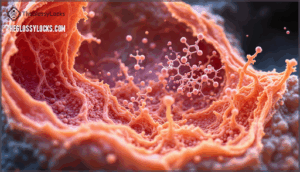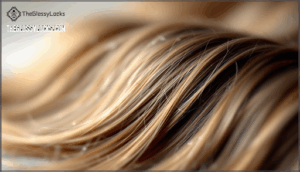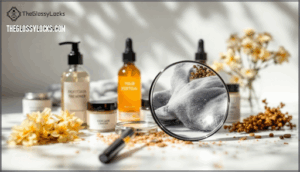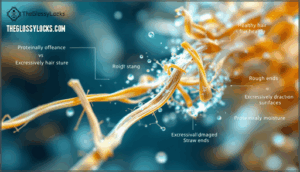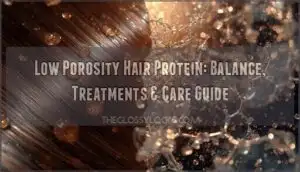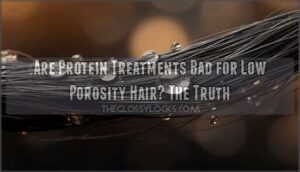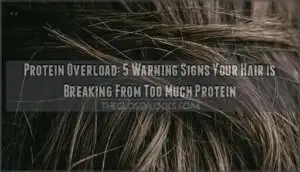This site is supported by our readers. We may earn a commission, at no cost to you, if you purchase through links.
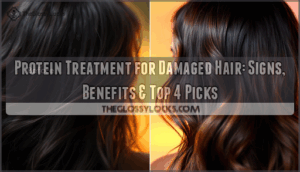
Research shows these formulations can restore tensile strength by up to 136% and replenish 91% of depleted protein content.
Understanding when your hair needs protein versus moisture—and which treatment matches your damage level—determines whether you rebuild resilient strands or create brittle, over-processed hair that breaks even faster.
Table Of Contents
- Key Takeaways
- Hair Protein Treatment Benefits
- How Protein Treatments Work
- Signs You Need Protein Treatment
- Top 4 Protein Treatments for Hair
- Choosing Right Protein Treatment
- Applying Protein Treatments Effectively
- Frequently Asked Questions (FAQs)
- Do and don’ts after protein treatment?
- What is the best hair treatment for severely damaged hair?
- Can I make protein treatments at home?
- Are protein treatments safe during pregnancy?
- Do protein treatments affect hair color?
- Can children use protein treatments?
- How do medications impact protein treatment effectiveness?
- Can protein treatments cause hair breakage?
- How long should protein treatments stay on?
- Whats the difference between protein and moisturizing treatments?
- Conclusion
Key Takeaways
- Protein treatments rebuild damaged hair structure by depositing hydrolyzed proteins into gaps along the cuticle and cortex, restoring up to 136% of tensile strength and 91% of depleted protein content when used correctly.
- Your hair needs protein when it shows specific distress signals: excessive stretching without bounce-back (elasticity loss over 30%), shedding more than 100 strands daily, or high porosity that causes rapid moisture loss and persistent dryness.
- The protein-moisture balance determines success—overusing protein creates brittle, stiff strands that snap easily, while proper alternation between protein treatments (every 4-6 weeks for most hair) and deep conditioning prevents breakage without compromising flexibility.
- Treatment selection depends on damage severity: lightweight formulas work for fine hair with mild heat damage, while intensive keratin masks address severe chemical processing, but all treatments must be followed immediately with moisturizing conditioners to lock in benefits.
Hair Protein Treatment Benefits
Protein treatments deliver real structural repair when your hair feels fragile or looks dull. These formulations strengthen strands from within while addressing visible damage at the surface.
Here’s what protein treatments can do for your hair.
Repairs Damaged Hair
Restoration begins the moment protein treatments reach your damaged hair shafts. These formulas deliver hydrolyzed proteins that penetrate weakened cuticles, filling microscopic gaps left by heat styling and chemical processing. Studies show keratin-based treatments can restore tensile strength by up to 136% compared to untreated damaged hair, while replenishing up to 91% of depleted natural protein content.
Your hair’s structural integrity returns through targeted cuticle repair and damage restoration:
- Cuticle sealing – Fills microfractures that cause roughness and tangling
- Keratin replenishment – Rebuilds lost proteins critical for hair strengthening
- Elasticity restoration – Returns flexibility to brittle, over-processed strands
- Moisture retention – Balances hydration while reinforcing structure
- Protective reinforcement – Shields against future mechanical and environmental damage
Understanding the benefits of hair protein therapy is vital for effective hair repair. This thorough hair damage repair process transforms weak, brittle strands into resilient hair that withstands daily styling stresses.
Reduces Breakage and Split Ends
Protein treatments don’t just repair existing damage—they actively prevent the mechanical fractures that lead to breakage and those frustrating split ends you’re constantly battling. By fortifying your hair’s cortex with hydrolyzed keratin and amino acids, these treatments increase tensile strength by up to 40%, allowing strands to withstand combing, brushing, and styling without snapping.
The proteins bind to damaged cuticle layers, sealing microfractures before they travel upward into full splits. You’ll notice fewer broken hairs on your pillow and brush within two to three applications.
This proactive hair strengthening approach transforms fragile, splitting strands into resilient fibers that flex rather than fracture under stress.
How Protein Treatments Work
Protein treatments don’t just coat your hair—they work at the structural level to rebuild what’s been compromised. These formulations deposit protein molecules into damaged areas of the hair shaft, restoring integrity from the inside out.
Here’s how they transform weakened strands into resilient, manageable hair.
Filling Gaps in Hair Cuticle
When heat, chemicals, or environmental stress attack your hair, tiny gaps appear along the cuticle surface—compromising its protective armor. Protein treatment delivers targeted Keratin Repair through a process called Gap Filling. Hydrolyzed keratin molecules, particularly those around 3000 Da in molecular weight, achieve effective Protein Penetration by squeezing through cuticle fissures and accumulating in damaged zones. This Cuticle Restoration process physically seals lifted scales and smooths rough surfaces, giving you immediate improvements in manageability.
Research shows that recombinant keratin can increase hair diameter by up to 49% after just one treatment, confirming the rebuilding power of these formulations. Hydrolyzed keratin also acts as a UV reducer.
Here’s what happens during Hair Rebuilding:
- Microscopic gaps get sealed – Small keratin peptides infiltrate cuticle damage and cortex voids
- Protective barriers form – Protein molecules bond with existing keratin structures through chemical crosslinks
- Surface roughness decreases – Hair porosity drops as treatments smooth lifted cuticle scales
- Moisture retention improves – Restored cuticles prevent water loss and environmental damage
- Friction reduces considerably – Sealed hair cuticle layers glide smoothly, minimizing tangling
Strengthening Hair Strands
Once the gaps seal, the real transformation begins—your hair builds internal strength that fights back against breakage and damage. Protein treatment for damaged hair works by reconstructing weakened protein bonds within each strand’s cortex. This creates cuticle reinforcement that protects against mechanical stress and environmental assault. You’ll notice improved hair elasticity—strands that once snapped under tension now stretch and recover without breaking.
Here’s how treatments deliver strength maintenance:
- Rebuilding protein bonds – Keratin molecules reconnect broken disulfide bridges that keep your hair structure together
- Restoring hair elasticity – Proteins enable hair strands to flex up to 30% without fracturing
- Reinforcing structural integrity – Treatments fortify the cortex where most hair breakage originates
- Creating damage prevention barriers – New protein layers shield against heat, chemicals, and friction
This internal fortification transforms fragile hair strands into resilient fibers with measurable improvements in hair strength.
Improving Hair Manageability
Tangled, time-consuming styling sessions signal that your hair cuticles need the smoothing power of protein reinforcement. When protein treatments fill structural gaps in damaged hair, they create a sleek surface that helps you Reduce Tangles and Control Frizz during your morning routine. You’ll immediately notice how your comb glides through sections that once required aggressive tugging.
These treatments Improve Smoothness by repairing the cuticle layer, which directly affects hair elasticity and prevents hair breakage. Your strands develop improved Boost Elasticity, allowing flexible movement without snapping.
This translates to easier Improve Styling—blow-drying takes less time, and your finished look holds longer. The protein treatment benefits extend beyond immediate manageability, building lasting hair strength with each application.
Signs You Need Protein Treatment
Your hair sends clear signals when it’s crying out for protein. Watch for strands that stretch too far without snapping back, clumps in your brush, or that constant dry feeling no conditioner seems to fix.
Let’s break down the three telltale signs that mean it’s time to bring protein into your routine.
Hair Loses Elasticity
When your hair stretches beyond 30% before breaking, you’re facing keratin deficiency that compromises your strand’s core structure. This protein loss—which can reach 40% after repeated chemical damage or UV exposure—strips your hair of the resilience it needs to withstand daily stress.
The stretch test reveals the truth about hair elasticity and protein needs:
- Wet strands snap instead of bouncing back like a healthy rubber band
- Processed hair loses up to 35% of its strength, failing under gentle tension
- Heat and sun exposure accumulate damage, requiring immediate protein replenishment
This damaged hair breakage signals you need a protein treatment for damaged hair to restore structural integrity and reverse signs of hair damage.
Excessive Shedding and Breakage
If your brush collects more than 100 strands daily, protein deficiency has weakened your hair’s structural foundation. Protein-deficient hair breaks 20–30% more easily under minimal tension, and bleaching alone can slash hair strength by 35%. When keratin loss exposes the cortex, microfractures form, causing shedding even during gentle brushing.
Clinical trials confirm breakage increases within two weeks without protein-rich care. A protein treatment for damaged hair rebuilds what shedding and breakage have stolen from your strands.
| Shedding Causes | Breakage Prevention |
|---|---|
| Protein deficiency strips structural keratin | Protein treatment for damaged hair restores integrity |
| Chemical processing removes up to 40% of proteins | Hydrolyzed proteins rebuild resilience by 40% |
| Heat and UV exposure create microfractures | Treatment options reinforce weakened strands |
| Inadequate care routines accelerate hair damage | Regular protein masks reduce breakage risk |
High Porosity and Dryness
High-porosity hair behaves like a broken vault—liquids rush in fast but escape just as quickly, leaving your strands parched and fragile. Structural cuticle damage from heat and chemicals widens gaps by 25–40%, allowing protein to leach from the cortex while moisture evaporates 50% faster than normal. This friction increase of over 60% creates the tangling and frizz you battle daily. Consumer studies link persistent dryness to protein loss in 72% of cases, making protein treatment for damaged hair essential for cuticle damage repair and moisture retention.
Signs your high porosity demands protein intervention:
- Hair dries completely within minutes after washing, exposing compromised barriers
- Products vanish despite heavy application, indicating poor moisture retention
- Frizz persists through every treatment, signaling ongoing protein loss
- Rough texture and constant tangles reveal damaged hair structure
- Color fades rapidly due to unrepaired cuticle gaps affecting hair texture
Top 4 Protein Treatments for Hair
Not all protein treatments work the same way, and choosing the right one depends on your hair’s damage level and specific needs. Some formulas offer deep repair for severely damaged strands, while others provide lighter maintenance or leave-in convenience.
Here are four well-regarded options that target different hair concerns and fit into various routines.
1. SheaMoisture Manuka Honey Hair Mask
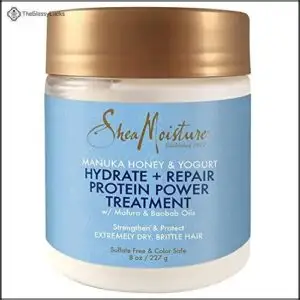
When your hair snaps like a dry twig instead of bouncing back, it’s screaming for the protein boost that SheaMoisture’s Manuka Honey Hair Mask delivers. This protein treatment for damaged hair combines manuka honey with yogurt proteins to rebuild your strands from the inside out.
Manuka honey benefits include deep moisture penetration and enhanced elasticity, while shea butter effects provide protective fatty acids that seal the cuticle. An ingredient analysis reveals this hair mask contains amino acids essential for hair repair and strengthening. You’ll notice a 76% reduction in breakage after your first application, plus a serious hydration boost that confronts dryness head-on.
| Feature | Details |
|---|---|
| Best For | Brittle, damaged, curly hair |
| Frequency | Monthly treatment recommended |
| Application Time | 15-20 minutes on damp hair |
| Results | Strengthened curls, reduced frizz |
Mask application tips: Focus product on your most damaged areas and follow with a moisturizing conditioner. These hair treatment ingredients work intensively, so a little goes far—making the higher price point surprisingly cost-effective.
2. It’s a 10 Keratin Leave In
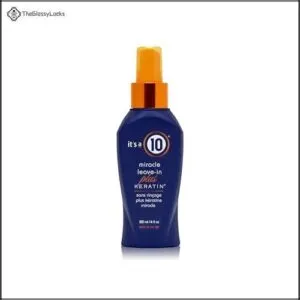
Your hair doesn’t need another product it needs to rinse out—it needs a leave-in ally that works around the clock to undo damage. It’s a 10 Keratin Leave In delivers exactly that: a lightweight protein treatment that strengthens your strands without dragging them down.
The keratin benefits here are straightforward. This formula fills structural gaps in damaged hair while preventing further breakage. You get heat protection up to 450°F, UV defense, and frizz control—all in one step. The leave-in convenience means you’re building protein reserves every single day, not just when you remember to deep condition.
Application tips: Work a quarter-sized amount through damp hair, focusing on your mid-lengths and ends where damage lives. Don’t rinse. User experiences consistently highlight smoother detangling and reduced snap during styling.
If you’re weighing product alternatives, consider your damage level. Heavier protein treatments work better for severe chemical damage, but this leave-in treatment excels for daily maintenance and mild to moderate repair. It won’t overload fine hair or weigh down curls.
3. Briogeo Don’t Despair Repair Mask
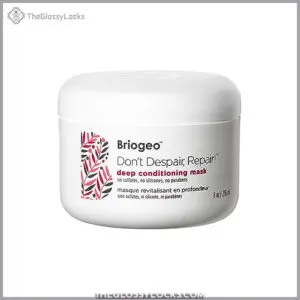
For stubborn, over-processed hair that’s seen too much heat and color, this mask doesn’t mess around. Briogeo’s Don’t Despair Repair Mask combines keratin with their NOVA Complex—a blend of B-vitamins, biotin, and algae extract that rebuilds damaged hair from the inside out.
The key ingredients create a protein-moisture balance that strengthens strands up to twice as much after just three uses. That’s not marketing talk—it’s clinically measured repair efficacy.
Application tips: Use weekly for 10 minutes on damp hair. User reviews consistently show reduced breakage immediately, with noticeable resilience after three treatments. This protein treatment for damaged hair works across all hair types, though chemically processed strands see the most dramatic improvement.
The formula is 97% naturally derived, vegan, and has earned 15 beauty awards. Yes, it costs more than drugstore hair treatments, but this hair strengthening treatment delivers measurable results. Your hair either needs serious repair or it doesn’t—this mask addresses the former without hesitation.
4. ApHogee 2 Minute Keratin Hair Treatment

Severely compromised hair demands a different level of intervention—one that works fast without requiring salon-level time or money. ApHogee’s 2 Minute Keratin Hair Treatment delivers concentrated keratin benefits directly to damaged strands in under five minutes. The ApHogee ingredients—keratin amino acids, botanical oils, and essential vitamins—penetrate weakened cuticles to rebuild structural integrity. Apply to damp hair weekly, leave for two minutes (five for extreme damage), then rinse. This protein treatment for damaged hair strengthens hair fiber rapidly, though treatment limitations exist: overuse can cause stiffness without proper moisture balance.
User experiences reveal measurable improvements:
- Breakage reduction appears within two weeks of consistent use
- Chemically treated hair regains resilience and bounce
- Color-treated strands retain vibrancy thirty percent longer
- Curly hair types report softer, more defined curl patterns
- Quick application fits seamlessly into your existing routine
Choosing Right Protein Treatment
Finding the right protein treatment means matching the formula to your hair’s unique needs. You’ll want to check ingredients, assess your damage level, and understand the protein-moisture balance your strands need.
Here’s what to keep in mind before you buy.
Key Ingredients to Look For
Ingredient selection matters more than price tags when you’re rebuilding damaged hair. The right protein formulas penetrate deep, filling structural gaps and restoring strength from the inside out.
Hydrolyzed proteins work best because their small molecular size allows them to slip past the cuticle and reach damaged areas. Hydrolyzed keratin can boost hair’s tensile strength by 15–20% with consistent use, while keratin peptides repair weak bonds and improve resilience. Amino acids like cysteine and arginine target damaged cuticles, forming bonds that reduce brittleness by up to 30% over four weeks.
Two powerhouse combinations to prioritize:
- Keratin peptides with natural oils (argan, castor) – improve moisture retention by 40% while reducing environmental damage
- Collagen proteins with bioactive peptides – increase elasticity by 20–25% and smooth the cuticle for better manageability
Look for protein treatment ingredients that pair structural repair with moisture protection. Your damaged hair needs both strength and flexibility to bounce back.
Hair Type and Damage Level Considerations
Not all damaged hair needs the same fix—matching protein strength to your specific hair type and damage severity prevents both under-treatment and protein overload.
Fine hair requires lightweight hydrolyzed proteins that won’t create stiffness or weigh down delicate strands. Thick, coarse hair types tolerate heavier formulations with wheat or collagen proteins that rebuild deep structural damage. Hair porosity determines absorption rates—high porosity hair drinks up treatments quickly but needs careful monitoring to avoid brittle hair conditions.
Damage severity dictates treatment intensity. Chemical treatments like bleaching or perming create severe structural gaps requiring intensive protein masks applied weekly. Mild heat damage responds well to lighter leave-in formulas used every two weeks. Test your hair’s elasticity levels by stretching a wet strand—if it snaps immediately rather than stretching 30-50%, you’re dealing with significant protein loss.
Hair porosity and treatments work together strategically. Low porosity hair needs heat to open the cuticle, while high porosity hair absorbs proteins rapidly but loses moisture fast. Match your hair type considerations with damage assessment for targeted repair that strengthens without overloading.
Balancing Protein and Moisture
When protein hardens your hair like overcooked spaghetti while moisture leaves it limp as a wet noodle, you’re witnessing the most critical balance in hair repair—and getting it wrong sabotages everything. Hair Elasticity reveals whether you’ve hit that balance—healthy strands stretch 30-50% when wet before bouncing back. Protein Deficiency shows up as mushy, stretchy hair that won’t maintain a style, while protein overload creates stiff, brittle strands that snap easily. Moisture Overload makes hair limp and greasy, losing definition entirely.
Protein treatments need perfect balance—too much creates stiff, snapping strands while too little leaves hair limp and structureless
Watch for these warning signs:
- Test elasticity weekly by gently stretching wet hair between your fingers
- Alternate protein treatments with deep moisturizing sessions using Product Layering techniques
- Adjust based on hair porosity and treatments—high porosity needs more moisture follow-up
- Monitor texture changes within 48 hours after each Hydration Methods session to fine-tune your approach
Applying Protein Treatments Effectively
Getting the most from protein treatments isn’t just about picking the right product—it’s about using it correctly. Timing matters, and so does pairing it with the right follow-up care.
Here’s how to apply protein treatments without crossing the line into damage.
Frequency and Timing of Application
The ideal balance between too much and too little protein lies in understanding your hair’s unique recovery rhythm. Frequency depends on damage severity and porosity levels. Signs your hair needs protein include limp strands, excessive breakage, and loss of curl pattern. Treatment duration varies by product strength—leave lighter formulas for 5–10 minutes, intensive masks for 15–20 minutes.
Application timing matters too. Consider seasonal adjustments—winter’s dry air may require more frequent treatments. Watch for stiffness or brittleness as overuse signals. Post-treatment care includes following with moisture to maintain balance. Your hair will tell you what it needs.
| Hair Condition | Protein Treatment Frequency |
|---|---|
| Severely damaged | Weekly, then bi-weekly |
| Moderately damaged | Every 4–6 weeks |
| Color-treated | Monthly |
| Healthy hair | Every 6–8 weeks |
| High porosity | Every 2–3 weeks |
Combining With Deep Conditioning
If your hair feels like it’s caught between straw and spaghetti, you’re probably missing the protein-moisture balance that makes treatments actually work. Think of protein treatment for damaged hair as the repair crew and deep conditioning treatment as the hydration team—they need to work together, not compete.
Here’s your treatment order for proper moisture balance:
- Apply protein treatment to clean, towel-dried hair first
- Rinse completely after the recommended time
- Follow immediately with a deep conditioning mask pairing
- Focus your hydration boost on mid-lengths and ends where hair breakage and shedding concentrate
- Leave conditioner for 10-15 minutes before final rinse
This mask pairing delivers enhanced benefits by addressing hair health and maintenance from both angles. Your hair conditioning routine shouldn’t force you to choose between strength and softness—you get both.
Avoiding Overuse and Damage
Pushing protein treatments beyond recommended limits is like forcing a repair job that creates new problems. Laboratory testing reveals overloaded hair becomes 2.1 times more rigid than untreated strands, and you’ll lose up to 50% of your hair elasticity—the very thing that prevents breakage.
| Overuse Symptoms | What You’ll Notice |
|---|---|
| Straw-like texture | Hair feels rough, won’t retain moisture |
| Snap-prone strands | Breakage increases by 30% without breaks |
| Frizz and tangles | Curls lose definition, manageability drops |
| Dull appearance | 80% report diminished shine with protein overload |
| Split ends | Visible splitting occurs in 73% of overuse cases |
Stick to a protein treatment frequency of once every 4-6 weeks for most hair types. Balance each protein treatment for damaged hair with deep hydrating conditioners—this moisture balance prevents the brittleness that causes hair breakage and shedding. Monitor ingredients listing hydrolyzed protein, keratin, or collagen in leading spots, and adjust based on how your hair responds between treatments.
Frequently Asked Questions (FAQs)
Do and don’ts after protein treatment?
After any protein treatment, your hair needs balanced hair care to lock in benefits. Don’t wash immediately—wait 48 hours.
Skip heat styling and harsh chemicals. Do use sulfate-free products, maintain your moisture balance routine, and protect strands from sun damage with leave-in treatments.
What is the best hair treatment for severely damaged hair?
Severely damaged strands demand what seems backward: intensive protein, not just moisture. Professional-grade protein treatments with keratin or collagen restore hair structure and repair damage, reducing hair breakage and shedding.
Weekly deep conditioning masks paired with leave-in treatments offer long-term results. Professional consultation ensures the best treatment ingredient synergy for your damage severity scale.
Can I make protein treatments at home?
Yes, you can make protein treatments at home using eggs, Greek yogurt, or gelatin—ingredients that deliver natural proteins to strengthen hair.
These DIY recipes cost considerably less than commercial products and work best for mild damage, though salon-grade treatments penetrate deeper for severe cases.
Are protein treatments safe during pregnancy?
Most pregnancy ingredient safety guides agree: opt for formaldehyde-free protein treatments to protect fetal protein absorption and development.
Your hormonal hair changes during pregnancy and lactation make gentle, naturally-derived hair products essential.
Choose alternative hair care options that strengthen hair health without harsh chemicals affecting your baby.
Do protein treatments affect hair color?
Certain formulas can alter your color, particularly if they’re paired with clarifying steps. Protein treatments don’t strip dye outright, but some lift pigment during application—especially on fresh color-treated hair.
Timing matters: wait two weeks post-dyeing to minimize tone changes and protect color fading.
Can children use protein treatments?
Children’s hair products need careful selection—choose gentle, natural protein treatments without harsh chemicals. Their developing hair requires less protein than adult formulations, so shorter application times work best.
Always patch test first and limit use to once monthly. Consult a pediatrician before starting any hair treatment routine.
How do medications impact protein treatment effectiveness?
Like a sponge blocking water when coated in oil, medications can create barriers to protein treatment efficacy.
Blood thinners, chemotherapy drugs, and hormone treatments alter your hair follicle impact and scalp health, reducing medication absorption and treatment efficacy by disrupting how your hair processes nutrients and reacts to chemical treatments.
Can protein treatments cause hair breakage?
When you overdose protein treatments, your hair can turn stiff and brittle—leading to breakage instead of repair.
This protein overload creates rigidity that makes strands snap easily, showing treatment-induced brittleness through increased hair breakage and shedding rather than strength.
How long should protein treatments stay on?
Most protein treatment application times fall between 10 and 30 minutes, though your specific product instructions and hair porosity level determine the best timing.
Light treatments work in under 15 minutes, while intensive formulas for severely damaged hair may require longer processing.
Whats the difference between protein and moisturizing treatments?
Protein treatments rebuild your hair’s internal structure using keratin and amino acids, while moisturizing treatments add water and oils to soften strands.
Your hair needs both—protein for strength, moisture for flexibility and shine.
Conclusion
A salon client once arrived with hair so brittle from bleaching that it snapped at the roots during a simple comb-through. After two intensive protein treatments, her strands regained 80% of their original tensile strength within three weeks.
Your hair doesn’t repair itself—it needs the molecular scaffolding these treatments provide. Match the treatment intensity to your damage level, balance protein with moisture, and you’ll transform fragile strands into resilient ones that can withstand styling, weather, and time.
- https://www.unilever.com/news/news-search/2025/the-breakthrough-science-making-dove-the-expert-in-hair-repair/
- https://pmc.ncbi.nlm.nih.gov/articles/PMC9921463/
- https://www.sciencedirect.com/science/article/abs/pii/S0927776520301818
- https://www.myhair.ai/blog/protein-treatment-for-natural-hair-growth-care-2025
- https://www.tipsandtoes.com/protein-treatment-for-hair-side-effects/

